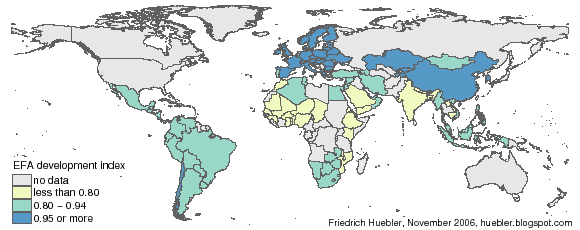 On 26 October 2006, UNESCO released the 2007 edition of the Education for All Global Monitoring Report. The annual EFA report assesses progress toward the goal of basic education for all children and adults by 2015. Individual countries are ranked with the EFA Development Index (EDI) that provides information for four of the six EFA goals:
On 26 October 2006, UNESCO released the 2007 edition of the Education for All Global Monitoring Report. The annual EFA report assesses progress toward the goal of basic education for all children and adults by 2015. Individual countries are ranked with the EFA Development Index (EDI) that provides information for four of the six EFA goals:- Universal primary education
- Adult literacy
- Gender parity
- Quality of education
- Early childhood care and education
- Learning needs of youth and adults
- Total primary net enrollment ratio (NER), the percentage of children of primary school age who are enrolled in primary or secondary school.
- Adult literacy rate. In countries without data on adult literacy, the share of the adult population with at least complete primary education is used as a proxy.
- Gender-specific EFA index (GEI). The GEI is a composite index that is calculated as the simple average of three gender parity indices (GPI):
- GPI for the gross enrolment ratio (GER) in primary education: GPI = female GER / male GER.
- GPI for the GER in secondary education: GPI = female GER / male GER.
- GPI for the adult literacy rate: GPI = female literacy rate / male literacy rate.
- If the calculation method for one of the three GPIs yields a value above 1 (because the female GER is greater than the male GER, or because the female literacy rate is greater than the male literacy rate), the calculation method is reversed. In such cases, the GPI is calculated as male GER / female GER, or as male literacy rate / female literacy rate.
- Survival rate to grade 5 as a proxy indicator for the quality of education. The survival rate to grade 5 is the share of children entering grade 1 of primary school who eventually reach grade 5, with or without repeating a grade.
- High EDI: 0.95 or more
- Medium EDI: 0.80 - 0.94
- Low EDI: less than 0.80

Data source: UNESCO. 2006. Education for All Global Monitoring Report 2007: Strong foundations - Early childhood care and education. Paris: UNESCO. Table 1, pages 200-201.
Of the 125 countries with data, 47 have a high EDI, which means they are close to or have already reached the goal of basic education for all children and adults. This group includes virtually all countries in Europe, as well as Armenia, Bahrain, Barbados, Chile, China, Costa Rica, Cuba, Fiji, Israel, Kazakhstan, Kyrgyzstan, Netherlands Antilles, Seychelles, South Korea, Tajikistan, and Trinidad and Tobago.
49 countries have a medium EDI between 0.80 and 0.94. This group includes most countries in Latin America and some countries in Africa and Asia.
Finally, 29 countries have a low EDI of less than 0.80. The twelve countries with the lowest EDI are all located in Sub-Saharan Africa. The lowest scoring countries are Chad (0.43), Niger (0.50), Burkina Faso (0.51), Mali (0.53), and Guinea (0.58). Countries with a low EDI outside of Africa include Bangladesh, Cambodia, Djibouti, India, Lao PDR, Nepal, and Saudi Arabia.
External links
- Education for All (EFA) goals
- EFA Global Monitoring Report web site
- Download the EFA Global Monitoring Report 2007 (PDF, 5.8 MB)
- Primary school enrollment in 2004
- Trends in primary school enrollment, 1970-2004
- Education disparity in South Asia
Permanent URL: http://huebler.blogspot.com/2006/11/efa-development-index-assessing.html
No comments:
Post a Comment